

Geo Map » Show What You Know with Media. A Geo-Map media project can include text, hyperlinks, images, and videos connected to locations on virtual maps.

Geo-Map projects can provide windows into events, concepts, places and stories which join disparate media elements into a cohesive digital narrative. Initial Setup Create web accounts on the websites you plan to use in your project.Download software (if required) you’ll use for your project. Ongoing Use Plan your project with a storyboard and script.Collect media artifacts you want to include in your project.Create your Geo-Map and share it. Milk carton wallet - English. Kids' Video Library. Man Crafts: zoetrope from coffee can. A zoetrope is a classic toy which, when spun, delivers the illusion of animation.
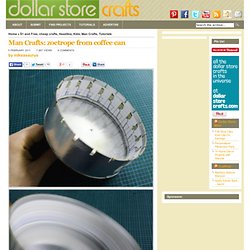
The construction is simple and the results are always fun to watch. Zoetropes work by using a cylinder with vertical slits cut along the top edge and a band of sequential drawings/photographs placed inside the cylinder. When the cylinder is spun the viewer looks at the images inside the cylinder through the vertical slots, resulting in each image blurring together in rapid succession creating the illusion of motion. With this easy to make and fun device you can make your own looping animations, regardless of your artistic abilities.
MSI - Online Activities - Grow a Garden in a Glove. Step 1 of 6: Here's the Materials You'll Need: Plastic glovePermanent markerFive types of seedsCotton ballsWaterPipe cleanerScissorsSoilSmall cups.
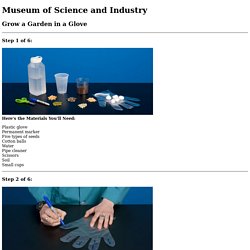
MSI - Online Activities - Identify Your Fingerprints. Step 1 of 9: Here's the Materials You'll Need: Non-toxic ink padLight-colored balloon (you also can use paper)Magnifying glass (optional) Step 2 of 9: Roll your finger from side to side in the ink pad.
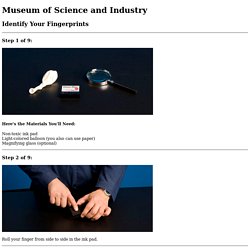
MSI - Online Activities - Make Slime. Step 1 of 6: Here's the Materials You'll Need: Borax (available in the laundry detergent aisle)Non-toxic white school glueWaterFood coloring (optional)StirrerMeasuring spoonsSmall container with lidPlastic cup Safety note: Borax is an irritant and should be kept out reach of children and pets.
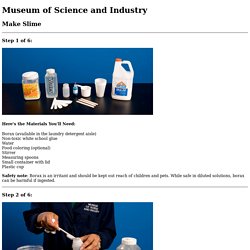
While safe in diluted solutions, borax can be harmful if ingested. MSI - Online Activities - Build a Lever. Step 1 of 7: The load is the object you are trying to lift.
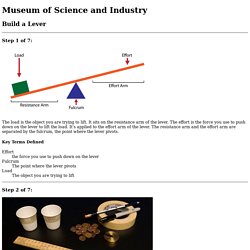
It sits on the resistance arm of the lever. The effort is the force you use to push down on the lever to lift the load. Pin by Cristina Flanagan-Saunders on stem - swing! MSI - Online Activities - Analyze Candy Using Chromatography. Step 1 of 9: Here's the Materials You'll Need: At least two kinds of candy-coated sweets (like M&Ms, Reese’s Pieces, Skittles) in the same color(brown works best) Coffee filters cut into 1” x 3” strips Toothpicks Small glasses Water Pen Key Terms Defined Chromatography A method for analyzing complex mixtures by separating them into the chemicals from which they are made.
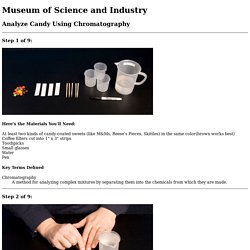
MSI - Online Activities - See the Colors in Leaves. Step 1 of 6: Here's the Materials You'll Need: Various types of leaves in different colorsSmall cupsCoffee filters cut into stripsNail polish removerPen Safety note: Nail polish remover is flammable; do not use near heat.

It also is harmful if ingested. Key Terms Defined. MSI - Online Activities - Make a Comeback Can. Step 1 of 7: Here's the Materials You'll Need: Empty can with a lid (like a coffee, oatmeal or paint can)Twist tie or short pipe cleanerHex nutLarge rubber bandScissors Step 2 of 7: Punch two holes in the lid and the bottom of the can.
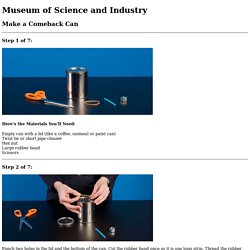
Cut the rubber band once so it is one long strip. Activity Detail. What You'll Need 8 strawsScisscorsRulerMasking tapePen or marker What to Do Measure and cut the straws into these lengths: 19.5 centimeters, 17.0 cm, 15.5 cm, 14.5 cm, 13.0 cm, 11.5 cm, 10.0 cm, 9.5 cm.
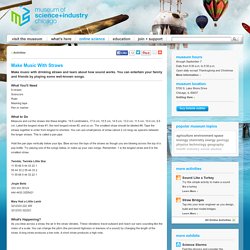
Label the longest straw #1, the next longest straw #2, and so on. Activity Detail. What You'll Need Paper cup Pencil String Scissors Paper clip Water What to Do Use a pencil to poke a hole in the bottom of the cup. Cut a piece of string about a foot long. Activity Detail. DESIGN SQUAD NATION . Build. DESIGN SQUAD NATION . Build. Make a Bouncing Polymer Ball - Fun Science Project.
Introduction Balls have been toys practically forever, but the bouncing ball is a more recent innovation. Bouncing balls were originally made of natural rubber, though now bouncing balls can be made of plastics and other polymers or even treated leather. You can use chemistry to make your own bouncing ball. Once you understand the basic technique, you can alter the recipe for the ball to see how the chemical composition affects the bounciness of the ball, as well as other characteristics. The bouncing ball in this activity is made from a polymer. Bouncing Polymer Ball Materials Here's a list of materials you need to gather to make bouncing polymer balls: Let's make bouncing polymers balls...
Polymer Projects Make Gelatin PlasticMake Plastic from MilkSlime RecipesMake Plastic Sulfur Plastics and Polymers Plastics and Polymers Science ProjectsExamples of PolymersWhat Is Plastic? Recycled Kaleidoscope. Step #1: PrevNext Remove all the raised edges from 1 half of the CD case, to get a flat piece of plastic. It’s easy to cut the plastic, if you’re careful. Score along the inside edges of the CD case with an X-Acto knife, running it along each edge about 6–8 times. DESIGN SQUAD NATION . Build. Inflatable Sculpture: Design Squad. Www.eie.org/sites/default/files/PDG_DesigningWaterFilters.pdf. How to Make a Gravity Puzzle (Brain Game) MSI - Online Activities - Read Without Seeing. Step 1 of 4: Here's the Materials You'll Need: PaperDried peas or beans, or small beadsGlueBraille chart (PDF) Step 2 of 4: Decide what you are going to write.
Start with something simple, like your name, before trying to write something longer. Step 3 of 4: Switch Braille writing with someone else, close your eyes and try to read the paper only using your fingers. 20/20 Vision - Activity. Summary Students determine their own eyesight and calculate the average eyesight value for the class. They learn about technologies to enhance eyesight and how engineers play an important role in the development of these technologies. Engineering Connection Engineers have created eye devices for people who have vision difficulties, including glasses and LASIK (laser-assisted in situ keratomileusis) eye surgery equipment.
Electrical engineers have applied their understanding of the eye to create microchips that can be implanted into the back of the eye. Educational Standards Each TeachEngineering lesson or activity is correlated to one or more K-12 science, technology, engineering or math (STEM) educational standards. Able Sports - Activity. Each TeachEngineering lesson or activity is correlated to one or more K-12 science, technology, engineering or math (STEM) educational standards.
All 100,000+ K-12 STEM standards covered in TeachEngineering are collected, maintained and packaged by the Achievement Standard Network (ASN), a project of JES & Co. Folding.pdf. Easy%20to%20build%20spectroscope.pdf. One-Hour CoasterBot. Step #1: Gather Your Parts PrevNext You can either gather the parts yourself or buy the Jameco CoasterBot parts bundle that we put together with them for our CoasterBot build project. It comes with all of the major parts you need (including the Ardweeny, the Breadboard Regulator, the servos, wheels, battery connector and battery snap, wire, etc.).